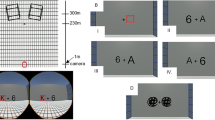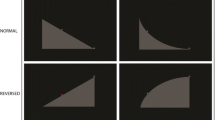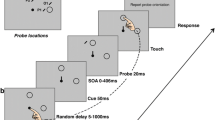Abstract
It is known that arbitrary target accelerations along the horizontal generally are extrapolated much less accurately than target speed through a visual occlusion. The extent to which vertical accelerations can be extrapolated through an occlusion is much less understood. Here, we presented a virtual target rapidly descending on a blank screen with different motion laws. The target accelerated under gravity (1g), decelerated under reversed gravity (−1g), or moved at constant speed (0g). Probability of each type of acceleration differed across experiments: one acceleration at a time, or two to three different accelerations randomly intermingled could be presented. After a given viewing period, the target disappeared for a brief, variable period until arrival (occluded trials) or it remained visible throughout (visible trials). Subjects were asked to press a button when the target arrived at destination. We found that, in visible trials, the average performance with 1g targets could be better or worse than that with 0g targets depending on the acceleration probability, and both were always superior to the performance with −1g targets. By contrast, the average performance with 1g targets was always superior to that with 0g and −1g targets in occluded trials. Moreover, the response times of 1g trials tended to approach the ideal value with practice in occluded protocols. To gain insight into the mechanisms of extrapolation, we modeled the response timing based on different types of threshold models. We found that occlusion was accompanied by an adaptation of model parameters (threshold time and central processing time) in a direction that suggests a strategy oriented to the interception of 1g targets at the expense of the interception of the other types of tested targets. We argue that the prediction of occluded vertical motion may incorporate an expectation of gravity effects.








Similar content being viewed by others
References
Assad JA, Maunsell JH (1995) Neuronal correlates of inferred motion in primate posterior parietal cortex. Nature 373:518–521
Benguigui N, Ripoll H, Broderick MP (2003) Time-to-contact estimation of accelerated stimuli is based on first-order information. J Exp Psychol Hum Percept Perform 29:1083–1101
Bennett SJ, Barnes GR (2006) Combined smooth and saccadic ocular pursuit during the transient occlusion of a moving visual object. Exp Brain Res 168:313–321
Bennett DJ, Gorassini M, Prochazka A (1994) Catching a ball: contributions of intrinsic muscle stiffness, reflexes, and higher order responses. Can J Physiol Pharmacol 72:525–534
Bennett SJ, Orban de Xivry JJ, Barnes GR, Lefèvre P (2007) Target acceleration can be extracted and represented within the predictive drive to ocular pursuit. J Neurophysiol 98:1405–1414
Bosco G, Carrozzo M, Lacquaniti F (2008) Contributions of the human temporoparietal junction and MT/V5+ to the timing of interception revealed by transcranial magnetic stimulation. J Neurosci 28:12071–12084
Brouwer A-M, Brenner E, Smeets JBJ (2002a) Hitting moving objects: is target speed used in guiding the hand? Exp Brain Res 143:198–221
Brouwer AM, Brenner E, Smeets JB (2002b) Perception of acceleration with short presentation times: can acceleration be used in interception? Percept Psychophys 64:1160–1168
Brouwer AM, Middleburg T, Smeets JB, Brenner E (2003) Hitting moving objects. A dissociation between the use of the target’s speed and direction of motion. Exp Brain Res 152:368–375
Brown LE, Wilson ET, Goodale MA, Gribble PL (2007) Motor force field learning influences visual processing of target motion. J Neurosci 27:9975–9983
Calderone JB, Kaiser MK (1989) Visual acceleration detection: effect of sign and motion orientation. Percept Psychophys 45:391–394
Cerminara NL, Apps R, Marple-Horvat DE (2009) An internal model of a moving visual target in the lateral cerebellum. J Physiol 587:429–442
de Lussanet MHE, Smeets JBJ, Brenner E (2001) The effect of expectations on hitting moving targets: influence of the preceding target’s speed. Exp Brain Res 137:246–248
DeLucia PR (2005) Does binocular disparity or familiar size information override effects of relative size on judgements of time to contact? Q J Exp Psychol A 58:865–886
DeLucia PR, Lidell GW (1998) Cognitive motion extrapolation and cognitive clocking process in prediction motion tasks. J Exp Psychol Hum Percept Perform 24:901–914
DeLucia PR, Tresilian JR, Meyer LE (2000) Geometrical illusions can affect time-to-contact estimation and mimed prehension. J Exp Psychol Hum Percept Perform 26:552–567
Dessing JC, Oostwoud Wijdenes L, Peper CL, Beek PJ (2009) Adaptations of lateral hand movements to early and late visual occlusion in catching. Exp Brain Res 192:669–682
Eggert T, Rivas F, Straube A (2005) Predictive strategies in interception tasks: differences between eye and hand movements. Exp Brain Res 160:433–449
Engel KC, Soechting JF (2000) Manual tracking in two dimensions. J Neurophysiol 83:3483–3496
Ferrera VP, Barborica A (2006) A flashing line can warp your mind. Neuron 49:327–329
Finke RA, Freyd JJ, Shyi GCW (1986) Implied velocity and acceleration induce transformations of visual memory. J Exp Psychol Gen 115:175–188
Freyd JJ, Finke RA (1984) Representational momentum. J Exp Psychol Learn Mem Cogn 10:126–132
Gabbiani F, Krapp HG, Koch C, Laurent G (2002) Multiplicative computation in a visual neuron sensitive to looming. Nature 420:320–324
Gottsdanker RM (1952) The accuracy of prediction motion. J Exp Psychol 43:26–36
Gottsdanker RM, Frick JW, Lockard RB (1961) Identifying the acceleration of visual targets. Br J Psychol 52:31–42
Gray R (2002) Behavior of college baseball players in a virtual batting task. J Exp Psychol Hum Percept Perform 28:1131–1148
Gray R, Thornton IM (2001) Exploring the link between time to collision and representational momentum. Perception 30:1007–1022
Indovina I, Maffei V, Bosco G, Zago M, Macaluso E, Lacquaniti F (2005) Representation of visual gravitational motion in the human vestibular cortex. Science 308:416–419
Jagacinski RJ, Johnson W, Miller RA (1983) Quantifying the cognitive trajectories of extrapolated movements. J Exp Psychol Hum Percept Perform 9:43–57
Kaiser MK, Hecht H (1995) Time-to-passage judgments in non-constant optical flow fields. Percept Psychophys 57:817–825
Lacquaniti F, Maioli C (1989a) Adaptation to suppression of visual information during catching. J Neurosci 9:149–159
Lacquaniti F, Maioli C (1989b) The role of preparation in tuning anticipatory and reflex responses during catching. J Neurosci 9:134–148
Lacquaniti F, Carrozzo M, Borghese NA (1993) The role of vision in tuning anticipatory motor responses of the limbs. In: Berthoz A et al (eds) Multisensory control of movement. Oxford University Press, Oxford, pp 379–393
Lang CE, Bastian AJ (1999) Cerebellar subjects show impaired adaptation of anticipatory EMG during catching. J Neurophysiol 82:2108–2119
Lisberger SG (1998) Postsaccadic enhancement of initiation of smooth pursuit eye movements in monkeys. J Neurophysiol 79:1918–1930
López-Moliner J, Field DT, Wann JP (2007) Interceptive timing: prior knowledge matters. J Vis 7:1–8
Maimon G, Assad JA (2006) A cognitive signal for the proactive timing of action in macaque LIP. Nat Neurosci 9:948–955
Makin AD, Poliakoff E, Chen J, Stewart AJ (2008) The effect of previously viewed velocities on motion extrapolation. Vision Res 48:1884–1893
Marinovic W, Plooy A, Tresilian JR (2008) The time course of amplitude specification in brief interceptive actions. Exp Brain Res 188:275–288
Marinovic W, Plooy A, Tresilian JR (2009) The utilisation of visual information in the control of rapid interceptive actions. Exp Psychol 56:265–273
Mazyn LI, Savelsbergh GJ, Montagne G, Lenoir M (2007) Planning and on-line control of catching as a function of perceptual-motor constraints. Acta Psychol 126:59–78
McIntyre J, Zago M, Berthoz A, Lacquaniti F (2001) Does the brain model Newton’s laws? Nat Neurosci 4:693–694
McIntyre J, Senot P, Prévost P, Zago M, Lacquaniti F, Berthoz A (2003) The use of on-line perceptual invariants versus cognitive internal models for the predictive control of movement and action. In: Proceedings of the first IEEE EMBS conference on neural engineering Capri March 20–22, pp 438–441
Merchant H, Battaglia-Mayer A, Georgopoulos AP (2004) Neural responses during interception of real and apparent circularly moving stimuli in motor cortex and area 7a. Cereb Cortex 14:314–331
Michaels CF, Zeinstra EB, Oudejans RR (2001) Information and action in punching a falling ball. Q J Exp Psychol A 54:69–93
Miller WL, Maffei V, Bosco G, Iosa M, Zago M, Macaluso E, Lacquaniti F (2008) Vestibular nuclei and cerebellum put visual gravitational motion in context. J Neurophysiol 99:1969–1982
Miyazaki M, Nozaki D, Nakajima Y (2005) Testing Bayesian models of human coincidence timing. J Neurophysiol 94:395–399
Mrotek LA, Soechting JF (2007a) Predicting curvilinear target motion through an occlusion. Exp Brain Res 178:99–114
Mrotek LA, Soechting JF (2007b) Target interception: hand-eye coordination and strategies. J Neurosci 27:7297–7309
Mrotek LA, Flanders M, Soechting JF (2004) Interception of targets using brief directional cues. Exp Brain Res 156:94–103
Port NL, Lee D, Dassonville P, Georgopoulos AP (1997) Manual interception of moving targets. I. Performance and movement initiation. Exp Brain Res 116:406–420
Preuss T, Osei-Bonsu PE, Weiss SA, Wang C, Faber DS (2006) Neural representation of object approach in a decision-making motor circuit. J Neurosci 26:3454–3464
Rosenbaum DA (1975) Perception and extrapolation of velocity and acceleration. J Exp Psychol Hum Percept Perform 1:395–403
Scheidt RA, Dingwell JB, Mussa-Ivaldi FA (2001) Learning to move amid uncertainty. J Neurophysiol 86:971–985
Schlack A, Krekelberg B, Albright TD (2008) Speed perception during acceleration and deceleration. J Vis 8:1–11
Senot P, Prevost P, McIntyre J (2003) Estimating time to contact and impact velocity when catching an accelerating object with the hand. J Exp Psychol Hum Percept Perform 29:219–237
Senot P, Zago M, Lacquaniti F, McIntyre J (2005) Anticipating the effects of gravity when intercepting moving objects: differentiating up and down based on nonvisual cues J Neurophysiol 94:4471–4480
Sharp RH, Whiting HTA (1975) Information-processing and eye movement behaviour in a ball catching skill. J Hum Mov Stud 1:124–131
Snowden RJ, Braddick OJ (1991) The temporal integration and resolution of velocity signals. Vision Res 31:907–914
Soechting JF, Flanders M (2008) Extrapolation of visual motion for manual interception. J Neurophysiol 99:2956–2967
Soechting JF, Juveli JZ, Rao HM (2009) Models for the extrapolation of target motion for manual interception. J Neurophysiol 102:1491–1502 (Epub July 1)
Sundberg KA, Fallah M, Reynolds JH (2006) A motion-dependent distortion of retinotopy in area V4. Neuron 49:447–457
Teixeira LA, Chua R, Nagelkerke P, Franks IM (2006) Use of visual information in the correction of interceptive actions. Exp Brain Res 175:758–763
Todd J (1981) Visual information about moving objects. J Exp Psychol Hum Percept Perform 7:795–810
Tresilian JR (1993) Four questions of time-to-contact: an analysis of research in interceptive timing. Perception 22:653–680
Tresilian JR (1995) Perceptual and cognitive processes in time-to-contact estimation: analysis of prediction motion and relative judgment tasks. Percept Psychophys 57:231–245
Tresilian JR (1999) Visually timed action: time-out for ‘tau’? Trends Cogn Sci 3:301–310
Tresilian JR (2005) Hitting a moving target: perception and action in the timing of rapid interceptions. Percept Psychophys 67:129–149
Trewhella J, Edwards M, Ibbotson MR (2003) Sensitivity to the acceleration of looming stimuli. Clin Exp Ophthalmol 31:258–261
Vaina L, Giulianini F (2004) Predicting motion: a psychophysical study. In: Hecht H, Savelsbergh G (eds) Time-to-contact. Advances in psychology series. Elsevier, Amsterdam, pp 53–65
Viviani P, Campadelli P, Mounoud P (1987) Visuo-manual pursuit tracking of human two-dimensional movements. J Exp Psychol Hum Percept Perform 13:62–78
Werkhoven P, Snippe HP, Toet A (1992) Visual processing of optic acceleration. Vision Res 32:2313–2329
Zago M, Lacquaniti F (2005) Internal model of gravity for hand interception: parametric adaptation to zero-gravity visual targets on Earth. J Neurophysiol 94:1346–1357
Zago M, Bosco G, Maffei V, Iosa M, Ivanenko YP, Lacquaniti F (2004) Internal models of target motion: expected dynamics overrides measured kinematics in timing manual interceptions. J Neurophysiol 91:1620–1634
Zago M, Bosco G, Maffei V, Iosa M, Ivanenko YP, Lacquaniti F (2005) Fast adaptation of the internal model of gravity for manual interceptions: evidence for event-dependent learning. J Neurophysiol 93:1055–1068
Zago M, McIntyre J, Senot P, Lacquaniti F (2009) Visuo-motor coordination and internal models for object interception. Exp Brain Res 192:571–604
Acknowledgments
We thank Dr. Joseph McIntyre for discussions on preliminary results. Present affiliations of Marco Iosa: Unit F, Santa Lucia Foundation and Department of Human Movement and Sport Sciences, University of Rome “Foro Italico”, 00194 Rome (Italy). Research was supported by grants from the Italian Space Agency (Disturbi Controllo Motorio e Cardiorespiratorio), the Italian Ministry of University and Research (Programmi di ricerca di Rilevante Interesse Nazionale), and the Italian Ministry of Health (Ricerca Corrente and Ricerca Finalizzata Istituto Superiore Prevenzione e Sicurezza sul Lavoro).
Author information
Authors and Affiliations
Corresponding author
Rights and permissions
About this article
Cite this article
Zago, M., Iosa, M., Maffei, V. et al. Extrapolation of vertical target motion through a brief visual occlusion. Exp Brain Res 201, 365–384 (2010). https://doi.org/10.1007/s00221-009-2041-9
Received:
Accepted:
Published:
Issue Date:
DOI: https://doi.org/10.1007/s00221-009-2041-9




